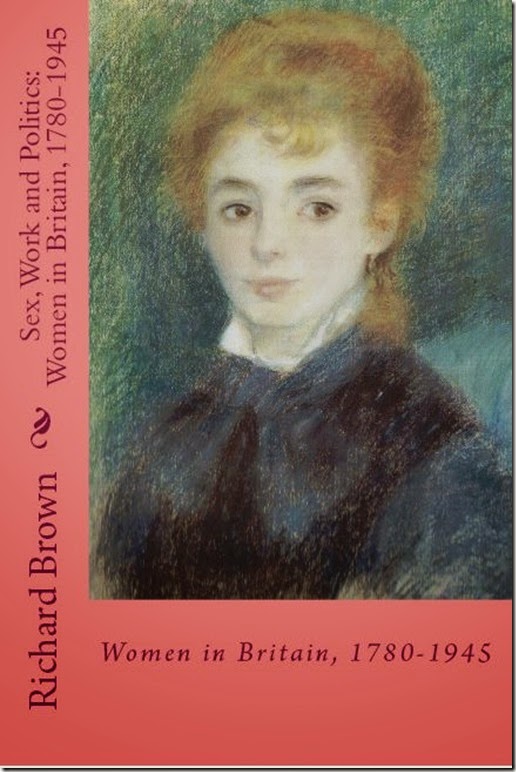JUST PUBLISHED
Although it’s only two years since I produced Sex, Work and Politics, writing a second edition has allowed me to extend its chronological limits back to the 1780s and forward to the end of the Second World War in 1945. The original structure of the book remains unaltered though each chapter has been remodelled to take account of this change and of research published since early 2012. In particular, I have made wider use of contemporary newspapers to position women more firmly within their varied milieus. I have also added two new chapters that consider the role played by women after they received the vote in 1918 and 1928 and the place of women in Britain’s imperial project after 1780.
The first chapter considers the relationship between different approaches that have evolved to explain the role of women in history. This is followed by a chapter that looks at the ways in which women were represented in the nineteenth century in terms of the female body, sexuality and the notion of ‘separate spheres‘. Chapter 3 explores the relationship between women and work and how that relationship developed. For working-class women, the critical issue was their increasing economic marginalisation as the result of the masculinisation of work through control over technology, opposition to women’s role in the key sectors of the economy and the identification of certain types of work as specifically ‘female’. For middle-class women caught in the tightening vice of ‘surplus numbers’, the problem was that growing numbers of especially single women needed to find employment to maintain their social position but who often lacked the education necessary to do so. The growing professionalisation of women’s work with the emergence of teaching and nursing and the assault on the male preserve in medicine and the law was the critical development for the middle-classes.
Although women’s suffrage has had a symbolic importance for generations of feminists, the campaign for the vote has obscured the broader agitations for women’s rights during the nineteenth century and was, in terms of its impact before 1914, far less significant. Before the 1880s, the focus was not on winning the vote and the demand for parliamentary suffrage was only one of a range of campaigns. Between 1850 and 1880, a number of significant battles were fought and won. Some of these sought access to the public sphere in education, the professions and central and local government. Others aimed to improve women’s legal and economic status within marriage. Married women’s property rights, divorce, custody of children, domestic violence as well as prostitution were all significant areas in which Victorian middle-class feminists campaigned for changes in the male-oriented status of the law and the differing moral standards to which wives and husbands were expected to conform. This was particular evident in the successful campaign against the Contagious Diseases Acts from the mid-1860s and in the growing significance of girls’ schooling and the campaign for higher education, issues are examined in Chapter 4.
The following two chapters look at the ways in which women actively sought access to the public sphere through political activity and demands for suffrage reform. Women’s interest in securing access to political rights was not limited to the campaign for parliamentary suffrage and from the eighteenth century women—proto-feminists--had been challenging the patriarchy. Women, from working- and middle-classes were involved in political protest such as the Chartist movement and in campaigns against slavery and the Corn Laws. The growing powers given to various levels of local government also attracted their keen interest and in the arena of local party politics women were to play a prominent role as early as the 1870s. For some women, suffrage was not the central issue and, those women who supported the Fabian Society were more concerned with improving the economic status of women as a necessary precursor to gaining the vote. Although there had been calls for women’s suffrage from the early nineteenth century and especially after 1832, it was not until the mid-1860s that campaigns outside Parliament sought to influence and pressurise MPs to introduce suffrage reform. There may have been support within both Conservative and Liberal Parties for women’s suffrage but it was not seen as a priority by party leaders and had to rely on individual MPs being willing to introduce bills, all of which were defeated. After thirty years of intermittent campaigning, the suffrage organisations had not achieved any change in the franchise.
It was not until the first decade of the twentieth century that the suffrage movement achieved widespread national recognition largely through the activities of the militant Suffragettes led by the controlling Pankhursts and the non-militant campaigning of the Suffragists. These wings of the suffrage movement agreed about ends but disagreed about some of the means used to achieve those ends: it was a question of deeds or words. The nature of the suffrage campaign is considered in Chapter 7 while reactions to this from anti-suffragists and political parties form the core of Chapter 8. The impact of the First World War on women generally and the suffrage campaign in particular is discussed in Chapter 9. The critical question is whether women gained the vote in 1918 as a reward for their services during the war or whether it was a political imperative that could no longer be reasonably resisted. Chapter 10 considers the role played by women after they gained the vote in 1918 through to the end of the Second World War. Many women emigrated, either on their own or as part of families, to Britain’s growing colonial possessions after 1780. Chapter 11 examines the nature of their role in the development of these colonies. The book ends with an examination of the notion of ‘borderlands’ as a conceptual framework for discussing women in Britain between 1780 and 1945 and the ways in which their personal, ideological, economic, legal and political status developed and changed.

No comments:
Post a Comment